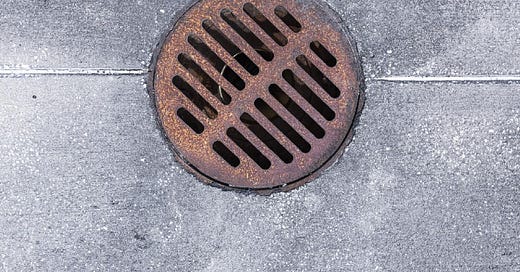You Paid WHAT For That Car?
Follow the 10-10-10 Rule, Get Off the Stupid Wheel, and Stop the Financial Drain
Dear Readers:
The following Saturday Soup post would fall into the “Financial Advice” column of life. Sometimes, we learn how to do things right by doing things wrong. This post outlines one of those times in my life along with some supporting anecdotes and data. You may already have things you’re doing that work for you. As we go through life, we can all learn from each other.
__________________________________
Forget About Vanity Purchases - Apply The 10–10–10 Rule to Your Next Car Purchase

My dad use to say, “A big boat is just a hole in the water that people pour money into”.
Billions and Billions — not just a book by Carl Sagan
That still holds true, of course, but in today’s world, automobiles have moved in to share that honor.
While recent trends are migrating to a more customer-centric marketing approach, manufacturers and Dealerships are adapting and perfecting digital marketing to reach young tech savvy millennials.
In a recent article, Digital Marketing Institute referenced this shift -
By 2020, the US automotive industry is forecast to spend $14 Billion on digital advertising, a growth of 13% per year. This significant growth demonstrates the importance of digital channels for the sector and the competition for the attention of car lovers is fierce.
According to Autotrader, more than 70% of younger Millennials cite technology and infotainment features as ‘must haves’ when purchasing a car, while 61% of car shoppers use video for research.
The strategy is clearly working

And not just on the younger generation.
A close friend in his mid-fifties recently purchased a new truck for more than I paid for my first house. His truck payment is over $700/month.
The combination of high tech, easy financing, and low credit auto buying has completely transformed the automobile market.
It use to be, when a young person wanted a special type of car (usually a mustang, GTO, or Camaro) they worked for it or built it. Credit was tight or non-existent.
Now, almost anyone can walk into a dealership and drive off with an $85,000 powerhouse that can cram maybe 2–4 people into it.
Financial Literacy Appears to be Almost Extinct
Those that still preach fiscal responsibility remind me of ones who try to revive and preserve a dying species. Ignorance and apathy too often prevail.
I use to work around a lot of young military members. Many out on their own for the first time with a regular paycheck (albeit low at that stage).
Most don’t have a clue about about managing finances.
No one ever taught them that when you spend more than you make, debt accumulates. A first time credit card is like a trying a new drug. The initial feeling of euphoria and liberation soon become enslaving shackles.
For the vast majority, that debt continues to grow and credit scores continue to plummet. A disastrous combination.
Many never seem to escape or even have the desire as long as they can get the things that keep their minds off the comfortable misery that governs their lives now.
There are still plenty of institutions that will lend money to individuals with low credit scores. There seems to be an explosion of “Buy here, pay here” used automobile dealers lining the highways approaching most metro areas to counter the growing debt problem (and take advantage of ignorance).
The young airmen I referred to earlier end up spending, on average, half of their monthly pay on a car (to include gas, insurance, and probably a few speeding tickets). “But, it has everything I want”, they reason”. Once convinced, it is almost impossible to dissuade them.
Time/Age Factor
Sometimes, even the time/age factor check light is broken and fails to alert one to stupidity, as referenced in my friend’s truck purchase above.

Then there’s those of us, who were never inclined to make stupid car purchases, but did it anyway — just to prove we could.
Young adults with cars especially like to be seen and admired.
I am no exception.
My very first car was my grandmother’s 1965 Chevy II that my brother and I shared. It had nothing of “value” for us, except getting from Point A to Point B. Immediately, however, we did whatever we could to make even this basic car look like it was the baddest car in the neighborhood - glasspack muffler, manually shifting the automatic transmission . . .
But, in the end, it was still just a Chevy II.
There have been only 2 times in my life that I paid more than $10k for a car.
The Really Stupid Time
The first one was the really stupid time.
For the first few years of marriage, my wife and I pretty much drove clunkers.
Both of us were either going to school full time, working, or both. We lived near everything and rode our bicycles almost everywhere, so never really needed much in the way of transportation.
But, then 1987 happened . . .
That was the year of the new VW Jetta design.
We were done with school (for the time being), both of us were working, and we had plenty of “spare” cash to “spend” for a change.
Flawed and foolish thinking, I know . . .
My financial literacy had not matured very much — all I knew was that I had extra money to spend (not save).
Therefore, it must be spent . . .

Smitten and Bitten
In late 1986, I fell in love with the new 1987 Jetta style that had just been launched. I saw it everywhere.
Then the justification phase set it.
When that happens, it’s pretty much a done deal.
Next thing I know, I’m at the VW dealership looking at a brand new Taupe colored Jetta, complete with sun/moon roof, on the showroom floor.
I remembered once I had seen a movie where a guy bought a car on the showroom and drove it right out the door. Without hesitation, I told the salesman that if they would let me do that, I would buy the car.
They did.
I did.

Reality plays cruel jokes sometimes
Less than a month later, my wife tells me she is pregnant with our first child.
Curve ball . . .
Besides being a trained nurse, she is also a very skilled piano player and teacher. Her goal was always to quit nursing when our children came along and teach music while raising our kids at home.
The reality of that was that our income would be significantly reduced. Less than a year later, bye-bye Jetta .
As a matter of fact, I brought my wife and baby daughter home from the hospital in that car and sold it (at a loss) less than a week later.
The Not So Stupid, But Foolish Time
The only other time we paid over 10k for a car was in 2003. It was a bank leased trade-in 2001 Chrysler Town & Country.
It had payments which we could afford at the time. We were able to pay it off early and kept it until it died, around 13 years later.
That one worked out OK, but I still labeled it foolish because it violated the 10-10-10 Rule.
This was in a time when there were a lot of layoffs happening in the area of the country we lived in. So, if I had lost my job before paying the car off, it may not have turned out so well.
One of the reasons I began buying cars under 10-10-10 Rule was that, even though we may have had a payment, it was usually very small and we could usually pay it off very quickly.
Surprisingly, with a little research, you can find very well maintained, visually appealing cars within these parameters. Economic slumps are a great time to buy because many will need to sell a vehicle quickly and are very negotiable.
But, you do need to be prepared, financially. That means saving up to buy with cash. Cash opens lots of otherwise closed doors.
Also, if you have some cash, a hybrid purchase is better than 100% financing. That way, the payment will be smaller, allowing you to continue building up a purchase fund.
Financial Awakening - Learning from our mistakes
Back to stupid vs. foolish -
Comparing those two purchases, along with managing a growing family had a huge impact on my financial literacy. I did not want my kids to be financially illiterate or learn things the hard way like I did.
The first purchase was an immediate loss of money, with a short-lived boost to the ego.
The 2nd purchase, even though it was more than $10k, showed me that it is possible to find a great bargain and keep it for a long time.
The internet changed everything
The two purchases above were pre-internet (at least for us).
As we slowly acclimated to digital life, a world of options opened up. Particularly for research.
As an avid reader, I was intrigued by stories of people whose income was equal or far less than mine and yet thrived financially.

I read books such as The Millionaire Next Door by Thomas J. Stanley and William D Danko who, surprisingly, found that most millionaires are “disproportionately clustered in middle-class and blue-collar neighborhoods and not in more affluent or white-collar communities”.
In other words, my neighbors and your neighbors — No flash, no fancy cars, no huge houses. Dept store clothes. Same as me. This fascinated me. What was I missing?
According to Stanley and Danko, there are two mindsets when it comes to wealth and financial soundness: UAW (Under Accumulators of Wealth) and PAW (Prodigious Accumulators of Wealth).
American’s Financially Literacy is Appalling
Due to financial illiteracy, most Americans fall into the first category.
Whole lifestyles (and perceived lifestyles) are wrapped around these two financial philosophies. Outward circumstances, at least in the beginning are relatively the same.
My financial philosophy was somewhere in between those two.
We were definitely not of the UAW school. However, because I had come into the game at a later stage of life, neither was I of the PAW school.
My goal was (is) to live as debt free as possible, which we doing.
Financial Success Does Not Have to be Large Scale or Glamorous

During this time, we have raised five successful children through college (debt free) with some financial astuteness. They all definitely lean toward the PAW end of the spectrum. We were never able to save (accumulate) a lot. Neither were we poor or in much debt - mortgage and a couple of the vehicle purchases (by choice -we could have paid cash, but chose the hybrid route to facilitate saving a larger fund for the next purchase).
Our children and I joke now about how they never knew how close we were, at times, to rock bottom. But, I refused to go into debt to have more or better.
What they did know is that there was always a roof over them, food on the table, and a warm bed to sleep in each night. We had enough.
And that was the lesson. Be content with enough, yet continue to improve financial literacy.
Our investment should be in the next generation.
Our financial philosophy plays a huge part in our success. The necessities of reliable shelter and transportation top the list.
To stay ahead of the marketer/consumer game, a healthy “Glamour Immunity” must be developed.
This was passed to our children. There was strict rules on TV watching, therefore our kids were rarely exposed to the lure of commercials.
The Official 10–10–10 Rule
As my financial philosophy changed, who I was became less defined by with what I owned.
Our transportation needs were a prime example.
Thus, the 10-10-10 Rule was officially established:
Whatever automobile we purchased must:
Be at least 10 years old
Have at least 10 more years of life
Be under $10k
Additionally, we try to stay within the 100k maximum miles range (preferably less).
As mentioned earlier, the internet became a huge research resource. Persistent research revealed that there were quite a few very nice cars that were at least 10 years old for around $10k. Many with surprisingly low mileage and suitable for another 10 years of life.
Keys to 10-10-10 Rule Success
Begin the research phase of the purchase process. The key is the willingness to search in roughly a 200 mile radius.
Don’t be afraid to ask hard questions over the phone.
You can find some great deals (see the 2008 Honda example below) with salvage titles. Don’t shy away from them, just do your homework.
Always get and check the VIN before going to see the vehicle, especially ones far away. If they won’t give that out, then forget that one.
Facebook Market Place and Craigs List have become the go to online platforms for buying/selling vehicles. Just tune your radar antennas to scams and stalkers. Never go look alone.
You must exercise some self-discipline here and not stop short because you found a vehicle you really like, but it falls way outside the 10–10–10 parameters.
Fudging a little is OK— $11000 or maybe an 8–12 years range, but nothing too extreme.
Depending on your financial discipline, the purchase may require financing, unless you have more cash saved up.
The goal is to pay it off as soon as possible.
For this you must establish a car purchase fund and act as if you are making a car payment. In ten years, you will have more than enough to make your next 10–10–10 purchase.
Regularly scheduled maintenance and cleaning will keep the car running well and looking nice for the long haul. Keep in mind, there will be exceptions that are out of your control.
In ten years, you will have a cash reserve for your next purchase and, hopefully, a well maintained used vehicle to trade or sell to reduce price even further.
Sometimes, this process allows you to be a a unique position to do a deal earlier than 10 years.
Repeat the process as necessary.
I realize this a very simplistic process and that there are many variables within a family, but with a little financial discipline, it very doable for most and will work for multiple vehicles when life necessitates.
Real Life Application of the10-10-10 Rule
This is a very affordable process for a multiple vehicle family.
Currently (2023), our family is driving:
A 2004 Toyota Sienna van - purchased for $9500 cash from Craigs List ad in 2015 with only 92K miles. Owner lived roughly 150 miles away. This vehicle has over 200k miles on it now and has significant wear and tear, but is still reliable local transportation. This one will need to be replaced in the next 2 years.
2008 Honda Civic - With only 47k actual miles . . . Best deal I’ve done so far under this plan. Purchased in 2022 for $7500 cash from a Facebook Marketplace ad. Vehicle has a salvage title because of an accident in which the rear passenger door was struck and deployed an airbag. Car was completely repaired to pristine condition and is very clean inside and out.
2011 Nissan Juke - $6500/136k miles found on Facebook Marketplace. Purchased to replace a totaled (paid for) 2009 Toyota Camry. This car was purchased for our youngest daughter, a college student, with Insurance cash payout.

Where to Search
The internet has greatly expanded the search options.
Online: Facebook Marketplace (best), Craig’s List (best), Auto Trader, Dealerships (do your due diligence for pricing with dealerships and always check carfax.com). Also, be willing to make a few road trips to nearby cities.
Private sales: individuals advertising a car along a street or in a parking area, local newspaper (not used much anymore), or auto trader publications found in convenience stores.
Friends or family
Bottom line — the deals are out there. You must be willing to exercise a little research time and self-discipline to find them.
Price Creep Will Probably Necessitate Rule Modification
The main caveat is that as automobile prices continue to creep higher, the rule may have to be modified a little to either a higher purchase price or a slightly older model.
Here’s To Your Wealth, whatever that may look like for you . . .
Tell me about financial strategies that you’ve developed that may be of benefit to the rest of us. Feel free to comment.
______________________________________
Next on the financial post list is an article about thoughts on building a “nest egg” vs. creating/acquiring assets that produce ongoing streams of income. Stay tuned.


